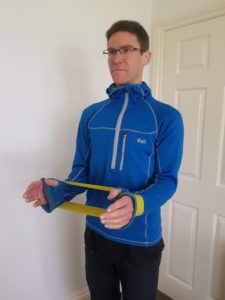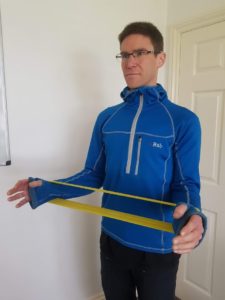I see a fair few climbers and gym athletes with shoulder issues. Although there are a huge number of climbing and shoulder related resources out there, I thought it might be nice to have a quick blog about the most mis-understood bits of the whole thing. The rotator cuff and how that relates to issues that appear in the training and climbing community.
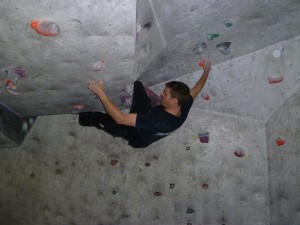
Note, this is a blog, not a peer reviewed journal, nor is it a self-diagnosis provider. It is something to read, and hopefully be educated with. If you need a diagnosis for yourself – see a professional.
How is it Diagnosed?
You do something to your shoulder and find it hard to move. Eventually someone persuades you to go to A&E to get an x-ray. The result: no breaks. Still can’t move your arm, and a pain in the shoulder? Must be a Rotator Cuff tear. Cheers- see you later. (No- this doesn’t happen every time, but it is a familiar enough story).
The follow up comment is often “I’ve been told by my Personal Trainer/doctor/guru it will never heal, so I need to strengthen my deltoid”.
Crikey – what a thing to be told! Something that will never heal? What a way to be thinking!
When we dig a little deeper to get some more understanding about what the patient knows – “so.. What do *you* understand by the term “rotator cuff”?” generally tends to be met with bafflement. Is it ligaments? Is it tendons? Does it need to be restored surgically? Can it be restored? Now I have a problem, is that it?!
Yes – There are a lot of misunderstandings around this part of the shoulder, so hopefully this will clear some of them up.
Basics
We have a fair few muscles attaching to the shoulder blade, arm and collar bone (which make up the shoulder). There are also a good number which don’t directly attach to these bones, but have an influence upon the movement of the joint. If any of these are injured, or tired, or whatever, then other muscles in the area will take on more load to enable you to continue climbing or training… Then *they* get tired and grumpy from doing stuff they don’t generally do and it all gets quite painful.
So what *IS* a rotator cuff?
Generally speaking, the rotator cuff are smaller muscles around the shoulder blade which stabilises the shoulder blade and the arm, enabling the bigger, more powerful muscles to do their thing and provide force to enable you to climb.
If you take nothing else away from this blog, take this:
The rotator cuff is made up of 4 muscles.
Muscles can get tired and grumpy, and cause all kind of problems and pain because they have been overworked – however, they don’t just stop working and they can certainly get better!
Let’s have a quick look at them
The ones which appear to cause the main amount of trouble (at least in my practice) are the Infraspinatus and the Teres Minor. They are both external rotators, and can be warmed up and strengthened with specific external 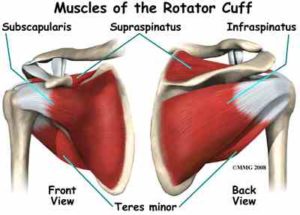 rotating exercises. Most climbers know about these, however, most climbers also do these exercises wrong. Not in terms of the overall movement, but in terms of specifics. The other two muscles, which I won’t go into here and now, but are just as important are Superspinatus and Subscapularis. Yes they can cause issues, but I’ll look at them at another time.
rotating exercises. Most climbers know about these, however, most climbers also do these exercises wrong. Not in terms of the overall movement, but in terms of specifics. The other two muscles, which I won’t go into here and now, but are just as important are Superspinatus and Subscapularis. Yes they can cause issues, but I’ll look at them at another time.
There is another external rotator which is NOT a rotator cuff muscle. Deltoid – that lovely teardrop shaped muscle over your shoulder. And while it is great for strength, it does NOT do what the rotator cuff does, and warming it up and strengthening it – while great, again, does NOT help gain stability in the rotator cuff.
What to do?
Here is a lovely exercise to gain strength and stability around the rotator cuff. It isn’t the only one, but it is my favourite:
Wrap a loop of elastic around your hands. Keep the elbow tucked in – imagine that your upper arm – the humerus – is the pivot around which you are rotating. Now rotate the wrists outward so that your hands are going away from each other, nice and slowly, don’t let the elbow pop away from your side – and then slowly let your hands come back together again…. Notice that the hand is inside the band of elastic. As soon as you grip something with your hand, the deltoid kicks in… we don’t want that – it isn’t part of what we are trying to strengthen. Start off with these, do them slowly, don’t bounce, and don’t do hundreds of them. 3×10 is enough. If you find that too easy, make it harder by increasing the tension on the elastic.
- position 1
- position 2
Having done this myself a fair amount, I have quite often found that I have overdone it and made the muscles fatigued and painful. Classic – who hasn’t overdone it at some point?! The way I managed the issue was to use a massage ball and massage around the area of the shoulder blade for a while (a few minutes). Excruciating, but ultimately it appears to have done my shoulder the world of good. A bit of strengthening (specific to rotator cuff) and a bit of massage, and I seem to be going quite well.
Points to absolutely remember:
The rotator cuff is made up of 4 Muscles (and tendons, if you’re being picky – they attach the muscles to the bones).
Unless you’ve had a pretty big trauma, with bruises and stuff, you are unlikely to have “torn” your rotator cuff.
Muscles heal.
Rotator cuffs can be rehabilitated.
If someone tells you that you “done your cuff in” and the only thing to do now is strengthen something else in its 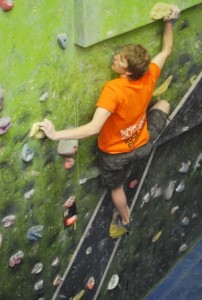 place, find someone else to listen to. Ideally, someone that knows what a rotator cuff is.
place, find someone else to listen to. Ideally, someone that knows what a rotator cuff is.
As ever – a disclaimer – this is a blog post, it is not meant to be researched to the nth degree, it is not published in a peer reviewed journal, it is not meant to be a substitute for seeing a professional and certainly isn’t on the hierarchy of evidence. If you have something up with your shoulder, go and see someone about it… preferably before you have to answer the question “so how long has this hurt for ” with the answer “about 2 or 3 years…..”





